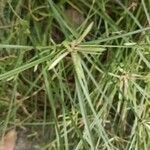Annuals. Roots fibrous. Culms tufted, 5-35 cm tall, ± slender, triquetrous, smooth, base with leaves. Leaves shorter than or sometimes equaling culm; sheath purplish brown; leaf blade 1.5-4 mm wide, flat, sometimes slightly plicate. Involucral bracts 3-5, leaflike, longer than inflorescence. Inflorescence a simple anthela; rays 2-7, 0.8-5 cm, each with 1 spike. Spike broadly ovoid to in outline subflabelliform, with 3-10 spikelets; rachis 2-5 mm. Spikelets densely and nearly digitately arranged, narrowly linear-ovoid, 1-2.5(-4) cm × 3-4 mm, basal ones spreading and apical ones obliquely spreading, 10-20-flowered; rachilla wings white, narrow, hyaline. Glumes pale to straw-colored on both surfaces and sometimes with rusty brown striae but middle green, tightly imbricate, ovate, 3-3.5 mm, thinly leathery, strongly folded, 9-13-veined, keeled, apex acute and with a straight and slightly long mucro. Stamens 3; anthers linear, 0.6-0.7 mm; connective apex reddish, ovate, ca. 0.1 mm. Style 0.9-1.3 mm; stigmas 3, 0.5-0.8 mm. Nutlet dark brown, obovoid, ca. 1/3 as long as subtending glume, 3-sided, slightly concave on 3 sides, puncticulate. Fl. and fr. Jul-Dec. 2n = ca. 98, 112, 114, 128.
Herbs, annual, cespitose with fibrous roots. Culms trigonous, (2–)6–15(–35) cm × (0.3–)1–1.8 mm, glabrous. Leaves 1–5, flat to V-shaped, (1–)5–15(–22) cm × (0.5–)1.5–3 mm. Inflorescences: spikes ± digitate, ± globose, 7–40 × 10–20 mm; rays (0–)1–6, 2–12 cm; if absent, inflorescence a sessile cluster of (1–)3–10 spikelets; rachis 2–5 mm; bracts (1–)4–5(–6), ascending, V-shaped, 1–15(–20) cm × 0.5–3.5 mm; rachilla persistent, wingless. Spikelets (1–)3–12(–16), greenish white, linear to linear-lanceoloid, compressed-quadrangular, 6–34(–40) × 2–3(–3.6) mm; floral scales deciduous, (8–)16–36(–42), spreading, laterally whitish, greenish, or pale brownish, medially green, weakly 7–9-ribbed, laterally weakly 1–2-ribbed, most ribs medial, ovate, (2.4–)2.6–3 × (1.9–)2–2.4(–2.5) mm, apex acute to ± acute, cuspidate tip (0.3–)0.5–0.7(–0.8) mm. Flowers: anthers 0.6–0.7 mm; styles 0.9–1.3 mm; stigmas 0.5–0.8 mm. Achenes brown, stipitate to sessile, obovoid, (1–)1.2–1.4(–1.5) × 0.9–1(–1.1) mm, apex obtuse to emarginate, surfaces very finely puncticulate.
Tufted annual 1–3 dm; lvs ± basally disposed, flat or folded, 1–2 mm wide; bracts 3–5, surpassing the infl, 1–2 mm wide; spikes few and sessile, or 1–4 rays present and up to 10 cm; spikelets 3–10, digitately spreading, 1–2.5 cm × 2–4 mm, flattened, 10–40-fld; rachilla persistent; scales 2.5–3.5 mm, broadly ovate, keeled, acuminate and with shortly excurrent midrib, multinerved, greenish, with broad, thin, coppery or pale (often also red-lineolate) margins; achenes shining brownish, broadly obovoid-trigonous, 1–1.4 mm. Sandy woods and fields; pantrop., n. near the coast to Del. and inland to Mo.
Plants annual, slender, the culms tufted, 10-40 cm. high; leaves 1.5-3 mm. wide, the sheaths reddish; inflorescence of simple umbels, sessile or less commonly on short rays; spikelets 1-2.5 cm. long, 3-5 mm. wide, 12-to 30-flowered, green, rachilla not winged; achene obovoid, 1.5 mm. long, sharply trigonous, with thick-ened angles and concave sides, lustrous brown to black.
A sedge. It is a herb that grows each year from seed. It grows 3-27 cm high. It forms small tufts. The stem can be up to 2 mm across. It is sharply triangle shaped. The blades are up to 16 cm long and 2.5 mm wide. They can be flat or folded. The flowers are in a small cluster of spikes.
A small to fairly robust, annual herb, up to 0.6 m high. Inflorescence a solitary head of 3-6 spikelets or a compound anthela consisting of one sessile group of spikelets and 1-10 stalked groups on 5-120 mm long peduncles. Spikelets 3-5 mm wide. Glumes grey to maroon.



